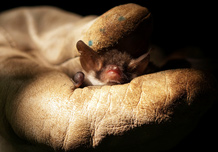
Natterer’s bat. Photo: Andrew Harrington.
Exeter student sheds new light on social life of bats
Ecologists are getting a unique and unexpected insight into the private lives of bats thanks to a University of Exeter PhD student.
Tom August is monitoring some 1,100 bird boxes in an Oxfordshire woodland using analytical techniques more commonly applied to study interactions between humans.
Speaking at the British Ecological Society's Annual Meeting at the University of Sheffield, Tom August explained that because many ringed bats regularly roost in Wytham Woods' bird boxes, he has been able to gain a unique insight into the bats' social networks.
Focusing on two species of bat, Daubenton's (Myotis daubentonii) and Natterer’s (M. nattereri), Tom and his team examined hundreds of bats that used the bird boxes as summer roosts over a period of five years. The bats are fitted with tiny aluminium arm bands with unique numbers, allowing individual bats to be identified. The researchers then used social network analysis to get a detailed picture of the bats' social groups.
They found that even though the bats change their roosts every few days, they almost always roost with the same group, forming tight-knit social groups with exclusive membership.
According to Tom, who is studying for his PhD in Biosciences and also works for the Centre for Ecology & Hydrology: “Our study shows that despite their frequent movements between roosts, bats form long-term companionships with other individuals, and that these companions are members of exclusive social groups that last for many years.”
The bats' habit of changing roosts every few days has made this kind of study very difficult in the past, Tom says: “The two bat species we studied are known to change roosts frequently, making their populations hard to study. However, the large number of bats with unique identification rings in Wytham Woods, and the bats’ routine use of bird boxes, have allowed us to resolve in detail how individual interactions scale up into population social structure. We show that populations are made up of social groups with strict membership, and that each social group has a territory which overlaps little with those of other groups.”
The results have important implications for both bats and humans. Bats are protected species in the UK due to loss of their natural roosting habitat. By revealing how bats stick together in distinct social groups, the study shows that conservation efforts should focus on groups rather than individuals. “Our work shows that to conserve a social group the area occupied by that group should be considered and not simply the single roost at which they may have been observed,” he explains.
Bats also carry several diseases harmful to humans, including rabies-like viruses. According to Tom: “Understanding how individual bats within a population interact with each other will help us understand how these diseases are spread through bat populations and may point to ways in which the risks to humans can be reduced.”
Date: 19 September 2011
